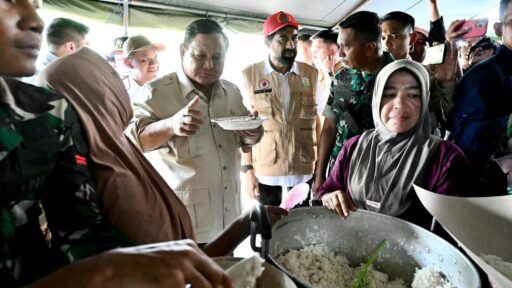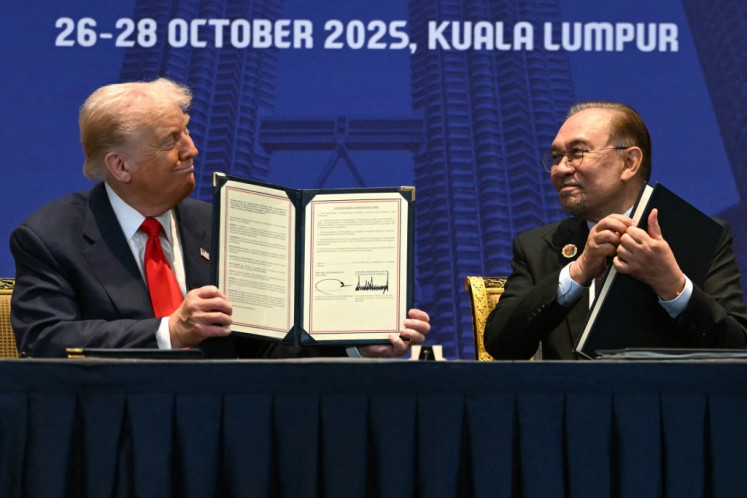Popular Reads
Top Results
Can't find what you're looking for?
View all search resultsPopular Reads
Top Results
Can't find what you're looking for?
View all search resultsReaching every child with vaccines
Vaccines save lives
Change text size
Gift Premium Articles
to Anyone
V
accines save lives. Every year vaccination averts 2 to 3 million infant deaths globally from deadly diseases such as diphtheria, hepatitis B, measles, mumps, pertussis, polio and tetanus.
However, at the same time 1 in 5 children, an estimated 21.8 million infants worldwide are still missing out on basic vaccines. Of them, 9 million infants, more than one-third, live in WHO's Southeast
Asia region.
Nearly 40 million children are born in the region every year. Only about 75 percent of them get all three doses of the diphtheria-pertussis-tetanus vaccine which protects against infectious diseases that can cause serious illness and disability or be fatal. Children miss out on vaccine for measles, a highly infectious viral disease that can cause serious complications, including blindness, encephalitis and pneumonia.
In 2013 about 26 percent of the global measles deaths, almost 38 000, occurred in Southeast Asian countries, 27 500 in India alone. These grim statistics underscore the need to intensify efforts to protect children with lifesaving vaccines. Why should children continue to die of diseases that can be prevented? We must close these vaccination gaps.
Our success against small pox historically and more recently in stopping poliovirus transmission in the region has demonstrated that we have the capacity to reach a large majority of children with vaccines.
Lessons learnt from these major public health wins, especially polio, need to be emulated in routine
immunization to reach the unreached ' the underserved children living in remote areas and in deprived urban and other settings ' to ensure equity with vaccines.
Disparities in vaccination coverage usually result from resource crunch, competing health priorities, poor management of health systems, inadequate monitoring and supervision and low awareness level among parents on the benefits of immunization.
Addressing these to continuously improve the quality and the reach of immunization service is a must to enable all children to benefit from vaccines.
It is encouraging to see the efforts being made by member countries. India, with the biggest birth cohort of 26 million, has been applying lessons and best practices from the polio eradication program to strengthen routine immunization.
It has launched a campaign focusing on 201 districts that have the highest number of partially vaccinated and unvaccinated children, for intensified efforts to increase immunization coverage in these districts.
Bangladesh is focusing efforts in 32 priority districts. Bhutan has mapped its hard-to-reach pockets with floating population across the country for targeted interventions. Indonesia is prioritizing immunization activities in 36 districts across seven provinces and Thailand is focusing on three southern provinces.
Member countries are also adding more vaccines to the immunization schedule, such as rubella vaccine and the pneumococcal conjugate vaccine (PCV). The Inactivated Polio Vaccine (IPV), which is injectable, is being included in routine immunization as part of the Polio Eradication & Endgame Strategic Plan.
While introduction of new vaccines is an opportunity to improve immunization services, increasing vaccination coverage is critical for meaningful introduction of any new vaccine.
However, not only should coverage be increased, it needs to be sustained to reap the benefits of immunization. Linking vaccines to delivery of other health interventions can ensure sustainability. At the core, however, is the strengthening of health systems to increase and sustain immunization coverage. We know from our recent experience from Ebola and other public health emergencies in the past that the role strong health systems play in rolling out a timely and adequate response is important.
Vaccination is a known cost-effective health intervention. Increasing vaccination coverage will accelerate control of vaccine preventable diseases and reduce death and diseases among children.
Vaccination is also a shared responsibility. Collective efforts are needed by government, partner agencies, health professionals, academia, civil society, media, private sector and the community itself. And all of the above should be steered by continued strong political commitment and backed with resources.
With concerted efforts, WHO Southeast Asia Region aims at maternal and neonatal tetanus elimination this year; measles elimination and rubella and congenital rubella syndrome (CRS) control by 2020; sustaining the victory over polio until the disease is eradicated globally; increasing immunization coverage to > 90 percent at the national level and to > 80 percent at the district level with the three doses of diphtheria-pertussis-tetanus vaccines.
Every child has the right to lead a healthy life, and vaccination is a vital step. The World Immunization Week ' celebrated in the last week of April ' aims at promoting the use of vaccines to protect against diseases.
This year the focus is on closing the immunization gap and reaching equity in immunization levels with renewed efforts.
________________
The writer is regional director of WHO Southeast Asia region.










